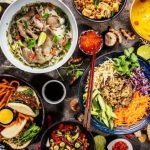Introduction:
Food is more than sustenance; it is a cultural expression, a source of comfort, and a means of connecting with others. The world of culinary delights is vast and diverse, reflecting the richness of global cultures and traditions. This article embarks on a journey into the multifaceted realm of food, exploring its cultural significance, nutritional importance, and the evolving landscape of culinary experiences.
Food is deeply intertwined with cultural identity and heritage. Traditional recipes passed down through generations carry the flavors and stories of a community. From the spices of Indian curry to the delicate artistry of Japanese sushi, culinary heritage is a testament to the diversity and richness of global cultures.
Rituals and Celebrations:
Food plays a central role in rituals, celebrations, and communal gatherings. Festivals, holidays, and family gatherings often revolve around special dishes that hold symbolic meaning. The act of sharing a meal fosters connection, strengthens social bonds, and reinforces a sense of belonging.
In the modern era, globalization has led to the fusion of culinary traditions, giving rise to diverse and innovative food experiences. Fusion cuisine combines elements from different cultures, resulting in unique flavor profiles and culinary creations that reflect the interconnected nature of the global community.
Beyond its cultural significance, food is the foundation of our nutritional well-being. A balanced diet provides essential nutrients, including carbohydrates, proteins, fats, vitamins, and minerals, necessary for the proper functioning of the body. Consuming a variety of foods in appropriate proportions supports overall health.
Dietary diversity is key to ensuring the intake of a wide range of nutrients. Different food groups contribute distinct nutritional benefits, and a diverse diet helps prevent nutrient deficiencies. Embracing a variety of fruits, vegetables, whole grains, lean proteins, and healthy fats promotes optimal health.
The Role of Superfoods:
Superfoods, nutrient-dense foods with exceptional health benefits, have gained popularity for their potential to boost well-being. Examples include berries, leafy greens, nuts, and seeds, each offering a unique combination of vitamins, antioxidants, and other bioactive compounds.
Cooking is a form of creative expression that transforms raw ingredients into delectable dishes. Chefs and home cooks alike engage in culinary creativity, experimenting with flavors, textures, and techniques to craft unique and memorable meals. The artistry of cooking celebrates innovation and personal style.
The world of cooking is rich with techniques that elevate the preparation of food. From sautéing and roasting to sous-vide and molecular gastronomy, culinary techniques vary across cultures and cuisines. Mastering these techniques enhances the texture, flavor, and presentation of dishes.
Farm-to-Table Movement:
The farm-to-table movement emphasizes the importance of sourcing fresh, locally grown ingredients. Supporting local farmers and producers not only ensures the quality and sustainability of ingredients but also strengthens the connection between consumers and the origins of their food.
The shift towards plant-based eating is a significant trend in the culinary world. Whether driven by environmental concerns, ethical considerations, or health reasons, more people are incorporating plant-based meals into their diets. Plant-based diets emphasize fruits, vegetables, legumes, and grains while minimizing or excluding animal products.
Sustainability has become a focal point in the food industry. Consumers are increasingly conscious of the environmental impact of their food choices. Sustainable practices include reducing food waste, choosing responsibly sourced ingredients, and adopting eco-friendly packaging.
Global Flavors and Street Food:
The appreciation for global flavors and street food has grown, reflecting a desire for authentic and diverse culinary experiences. Street food, with its bold flavors and regional specialties, has become a source of inspiration for chefs and a favorite among food enthusiasts seeking adventurous tastes.
Food security, ensuring access to sufficient, safe, and nutritious food for all, remains a global challenge. Issues such as food scarcity, unequal distribution, and the impact of climate change on agriculture underscore the need for sustainable solutions to address hunger and malnutrition.
Ensuring the safety of the food supply chain is a critical concern. Contamination, improper handling, and inadequate hygiene practices can lead to foodborne illnesses. Stringent food safety measures, from farm to table, are essential to safeguard public health.
As culinary traditions travel across borders, the risk of cultural appropriation arises. Misappropriation of traditional dishes or ingredients without understanding their cultural context can undermine the authenticity and respect for diverse culinary heritages.
Gastronomic tourism, or food tourism, has gained popularity as travelers seek immersive culinary experiences. Exploring local markets, participating in cooking classes, and savoring regional specialties become integral parts of the travel experience, highlighting the cultural significance of food.
Food has become a prominent theme in media, from television shows and documentaries to social media platforms. Culinary influencers, chefs, and food enthusiasts share their expertise, recipes, and culinary adventures, contributing to the global conversation about food and shaping culinary trends.
Virtual Cooking Communities:
The digital era has given rise to virtual cooking communities where individuals share recipes, cooking tips, and food experiences online. Social media platforms and dedicated food websites connect people from diverse backgrounds, fostering a global community united by a shared love for food.
Conclusion:
Food is a universal language that transcends borders, connecting people through shared experiences and flavors. Its cultural, nutritional, and creative dimensions make it a fundamental aspect of human life. As the culinary landscape continues to evolve, the appreciation for diverse cuisines, sustainable practices, and the artistry of cooking will shape the way we nourish our bodies and souls. Whether savoring a cherished family recipe, experimenting with innovative culinary techniques, or embarking on a culinary journey around the world, the world of food invites us to savor the richness of life’s culinary tapestry.





